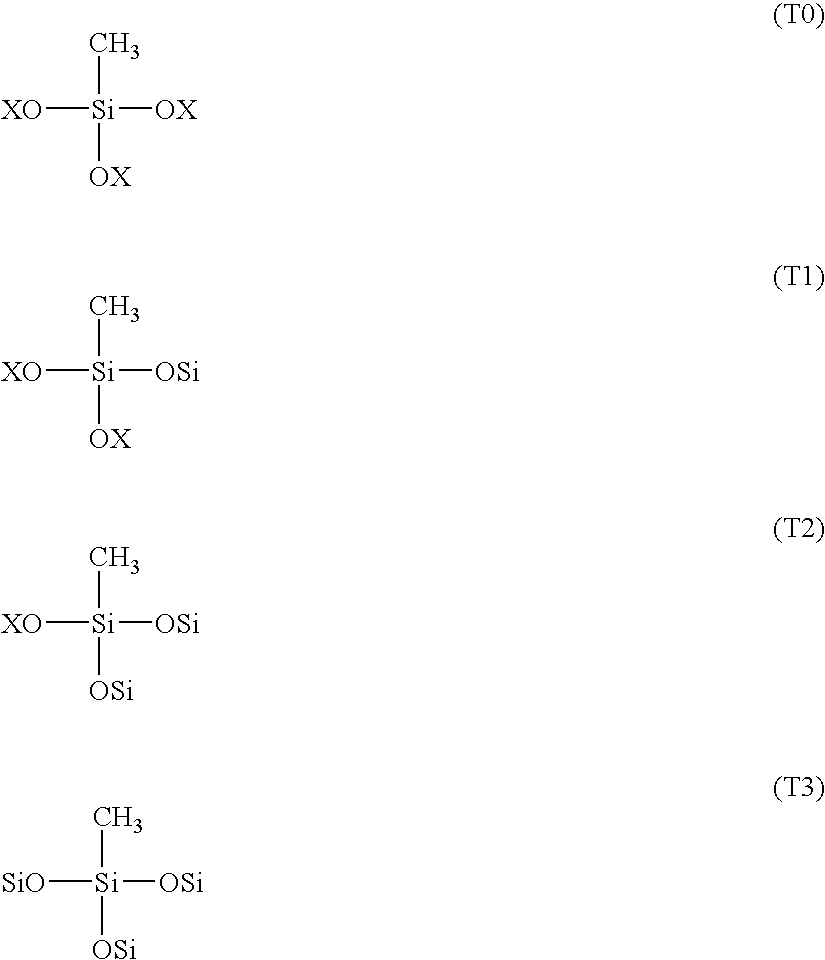Hardcoat compositions and hardcoated articles
a composition and composition technology, applied in the field of hardcoat compositions and hardcoated articles, can solve the problems of cracks in the hardcoat layer, less weather resistance of the hardcoat film formed on the plastic substrate, and insufficient adhesion between the hardcoat layer and the resin substrate, so as to improve weather resistance, improve the hardness, and the effect of transparency and adhesion
- Summary
- Abstract
- Description
- Claims
- Application Information
AI Technical Summary
Benefits of technology
Problems solved by technology
Method used
Image
Examples
synthesis example 1
[0083]A 5-liter three-necked flask equipped with a thermometer, agitator and condenser was charged with 1,360 parts of methyltrimethoxysilane and 381 parts of isobutanol. Under ice cooling, 1,350 parts of a water-dispersed silica sol (silica solids 20 wt %) was admitted for hydrolysis. The amount of water in the water-dispersed silica sol was 1,080 parts, corresponding to twice the molar amount (30 moles) of hydrolyzable methoxy groups. No particular catalyst was used since the water-dispersed silica sol was acidic. At the end of exothermic reaction, the solution was ripened for 2 hours at 50° C. Then 669 parts of propylene glycol monomethyl ether as a diluent solvent was added to form a coating solution A (solid concentration 25 wt %).
synthesis example 2
[0084]A 5-liter three-necked flask equipped with a thermometer, agitator and condenser was charged with 1,360 parts of methyltrimethoxysilane, 472 parts of γ-glycidoxypropyltrimethoxysilane and 513 parts of isobutanol. Under ice cooling, 1,215 parts of an acidic water-dispersed silica sol (silica solids 20 wt %) was admitted for hydrolysis. The amount of water in the water-dispersed silica sol was 972 parts, corresponding to 1.5 times the molar amount (36 moles) of hydrolyzable methoxy groups. At the end of exothermic reaction, the solution was ripened for 2 hours at 50° C. Then 450 parts of isopropanol, 670 parts of propylene glycol monomethyl ether and 308 parts of diacetone alcohol as diluent solvents were added to form a coating solution B (solid concentration 25 wt %).
synthesis example 3
[0085]A 5-liter three-necked flask equipped with a thermometer, agitator and condenser was charged with 1,780 parts of methyltriethoxysilane and 498 parts of isobutanol. Under ice cooling, 1,498 parts of a water-dispersed silica sol (silica solids 20 wt %) was admitted for hydrolysis. The amount of water in the water-dispersed silica sol was 1,198 parts, corresponding to 2.21 times the molar amount of hydrolyzable ethoxy groups. At the end of exothermic reaction, the solution was ripened for 16 hours at 25° C. Then 104 parts of propylene glycol monomethyl ether as a diluent solvent was added to form a coating solution C (solid concentration 25 wt %).
PUM
| Property | Measurement | Unit |
|---|---|---|
| Temperature | aaaaa | aaaaa |
| Percent by mass | aaaaa | aaaaa |
| Percent by mass | aaaaa | aaaaa |
Abstract
Description
Claims
Application Information
 Login to View More
Login to View More - R&D
- Intellectual Property
- Life Sciences
- Materials
- Tech Scout
- Unparalleled Data Quality
- Higher Quality Content
- 60% Fewer Hallucinations
Browse by: Latest US Patents, China's latest patents, Technical Efficacy Thesaurus, Application Domain, Technology Topic, Popular Technical Reports.
© 2025 PatSnap. All rights reserved.Legal|Privacy policy|Modern Slavery Act Transparency Statement|Sitemap|About US| Contact US: help@patsnap.com

